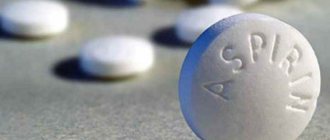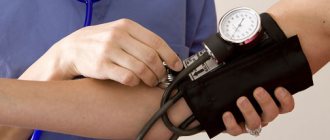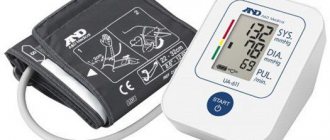Among all the pathologies of the cardiovascular system, high blood pressure is probably the most insidious condition. It can occur without pronounced symptoms; gradually the patient gets used to even the highest readings of the tonometer.
So much the worse for the person: he does not see a doctor, treatment does not begin, and ischemic processes develop in the body. Target organs suffer: heart, brain, kidneys.
At a certain point, a hypertensive crisis may develop. This is an emergency condition that requires urgent lowering of blood pressure. Otherwise, a stroke, heart attack and other serious processes, potentially fatal, are possible.
A pressure of 190 over 100 is also considered a variant of a hypertensive crisis; it urgently needs to be brought down, but this must be done gently so as not to harm the body. Qualified medical assistance is required.
Causes of hypertensive crisis
A crisis is a dangerous, relatively common emergency condition. It is observed in 30% of people suffering from hypertension.
Among the factors causing this phenomenon:
- History of hypertension. Crises occur most often in people suffering from hypertension. As a rule, with decent experience.
A crisis does not develop out of the blue; a certain trigger factor is required that will push the process in the desired pathological direction.
This factor may be alcohol consumption, coffee, sunstroke or heatstroke, or excess salt consumption the day before. There are other possible reasons.
- Menopause. The second factor in the ranking of the most common causes of high blood pressure.
Develops as a result of hormonal deficiency, imbalance of estrogen and progesterone.
In young years, a woman is protected from the development of severe forms of hypertension. By the age of 50, the body is no longer able to adequately and fully regulate vascular tone.
Hence the problems with the cardiovascular system.
- Atherosclerotic lesion of the aorta. When blood flow in the largest artery of the human body is disrupted, a spontaneous increase in blood pressure occurs.
Patients in the older age group (60-80 years) are susceptible to atherosclerosis, which is associated with senile changes in the body.
Over the years, cholesterol deposits calcify and get rid of them becomes very difficult.
- Kidney diseases. Including glomerulonephritis, pyelonephritis, nephritis. The so-called renal type of hypertension develops. It is characterized by a high degree of aggressiveness and the likelihood of a sudden hypertensive crisis. To prevent an unfavorable process, it is recommended to promptly treat all diseases of the nephrological profile (not to be confused with neurological ones).
- Nephropathy of various etiologies: diabetic, gestational. You should not assume that a sharp increase in blood pressure in pregnant women is something common. Hypotension with low blood pressure and bradycardia (pulse less than 60 beats per minute) is considered physiological. Hypertensive crises are a direct indication of pathological processes in the heart, kidneys or blood vessels.
- Periarthritis. Inflammation of periarticular structures.
- Lupus erythematosus. Systemic disease. Often causes complications on the cardiovascular system. Requires dynamic monitoring, preferably regular.
- Itsenko-Cushing's disease. Hypercortisolism or excess production of the hormone cortisol by the adrenal glands. Develops in diseases of the glands of this type and excessive secretion of corticotropin by the pituitary gland in tumors and injuries of the third ventricle. Blood pressure in Itsenko-Cushing's disease is constantly high, and hypertensive crises can develop repeatedly.
- Excessive production of testosterone and other hormones of the male body. All of them have a mobilizing effect, increasing vascular tone and causing blood pressure of 190/100 in men.
- Abrupt withdrawal of drugs against hypertension. This is the so-called withdrawal syndrome. Develops in 25-30% of patients who abruptly stop taking medications, especially with systematic, complex therapy.
In all cases, a trigger factor is required. In addition to those already mentioned: stressful situations, emotional overload, etc.
The pathogenesis of the conditions is different; it is necessary to understand it separately in each specific case.
Prevention
In order to avoid an increase in pressure not only to 190, but also to generally excessive levels, you need to remember about preventive exercises.
Morning jogging, walks in the evening, one and a half liters of clean water a day and healthy eight-hour sleep are the main basis of prevention and the path to health.
It is also recommended to eat small meals (little by little, but often) and give up bad habits.
Characteristic symptoms
Manifestations of hypertensive crisis are different in men and women. In representatives of the stronger sex, the intensity of symptoms is less. Otherwise, their list will be identical.
Characteristic symptoms include the following:
- Dyspnea. Feeling of lack of air. A subjective sign that does not indicate an objectively ongoing process in the respiratory organs.
- Impaired consciousness, including fainting and confusion.
- Intense headache and dizziness due to vasospasm.
- Visual impairment due to spasm of the blood vessels of the retina.
- Nausea.
- Vomit. Up to several times a day. Not accompanied by relief.
- Feeling of fear, panic attack.
- Cramps, muscle spasms.
- Nosebleeds due to rupture of small capillaries at the local level.
Danger signs
When dangerous complications develop, specific manifestations develop:
- Intense, pressing pain behind the sternum (possible heart attack).
- Difficulty speaking, gait, inability to control facial muscles (stroke).
- Pain in the back (problems with the aorta).
- Choking (heart failure, swelling of the pulmonary structures).
The duration of a hypertensive crisis is from several hours to 2-3 days. The longer the condition lasts, the higher the likelihood of fatal or disabling complications.
What does a low or high heart rate mean?
Not much about anything. Arrhythmias such as bradycardia (heart rate less than 60 beats per minute) or tachycardia (heart rate more than 80 beats per minute) are relatively rare in hypertensive crises. As a rule, at a pressure of 190 to 100 mmHg. Art. heart rate is normal.
Tachycardia indicates the development of life-threatening and health-threatening consequences, hemodynamic disturbances, and the development of a heart attack (acute ischemia of the heart muscle).
Additionally, noteworthy is the serious difference (90 units) between systolic and diastolic indicators (upper and lower pressure). This is the so-called isolated hypertension, which is even more dangerous.
Damage to target organs is likely: eyes, heart (myocardium), kidneys, cerebral structures, blood vessels. The possibility of death is also much higher (especially during a long-term crisis).
Systolic and diastolic
It's worth starting with the fact that pressure is always measured in two numbers, where the largest number is systolic pressure and the smallest is diastolic.
Systolic pressure is very often called simply “upper”. It serves to indicate the blood pressure at the time of one heartbeat.
And diastolic pressure (“lower”) shows us the same pressure, but at the moment of cardiac relaxation.
First aid
What to do if your blood pressure is 190/100? First of all, you need to call an ambulance. The patient is prohibited from making sudden movements; he must sit on the bed in a semi-sitting position. This will normalize blood circulation and make it easier to breathe.
Next, it is recommended to take an antihypertensive drug tablet (if prescribed by a doctor). It is important not to lower your blood pressure too sharply.
The maximum permissible rate of blood pressure decrease is 40-60 mmHg per hour. Faster - there is a possibility of developing the severe complications described.
It is also recommended to take medicine based on phenobarbital or other barbiturates: Corvalol, Valocordin. They will calm the nervous system and reduce the load on the heart.
Attention:
At a pressure of 190 to 100-105, it is not recommended to take specialized medications to quickly lower blood pressure levels. This is dangerous - the vessels may not withstand the load.
Among drugs of this kind are “Captopril”, “Clonidine”. An exception to the rule is when the doctor himself gave the recommendation along with the dosage regimen in emergency cases.
If pain develops in the chest or back, difficulty speaking and obvious suffocation, the patient must be immediately hospitalized in the cardiology department of the hospital.
In other situations, it is permissible to provide first aid on the spot, at home. In the future, it is recommended to consult a cardiologist to prescribe or adjust therapy.
What to do if the pressure is 190 to 90
If systolic pressure rises to 190 or more, then you should not hesitate. It is necessary to immediately call an ambulance, and provide pre-medical therapy before the doctor’s visit. If the patient is at home alone, then you need to help yourself. To do this you will need:
- Lie on the bed and put several pillows under your head so that it is on a higher ground. You can sit comfortably, lean back, and lower your arms.
- Drink ¼ Captopril tablet and place ¼ under the tongue for resorption.
- Take 30-40 drops of Corvalol, diluting it in water.
- Place mustard plaster on the back of the head for 3-5 minutes.
- Fill a basin with hot water and soak your feet in it for 5 minutes.
After the doctors arrive, you must say what medications were taken and describe your condition.
Treatment regimen
The therapeutic regimen involves systematic administration of drugs. Use pharmaceuticals with a blood pressure of 190/100 with caution.
It is necessary to prescribe a whole range of medications to combat arterial hypertension.
The following types of medications are used:
- ACE inhibitors.
- Medicines with diuretic action.
- Calcium channel blockers.
- Beta blockers.
Monotherapy (use of only one drug) rarely produces significant results. To enhance the effect and relieve the neurological component, it is recommended to take light sedatives based on the medicinal herbs Motherwort, Corvalol, Valerian.
In the case of third-party, extracardiac and extravascular etiology of the process, it is necessary to treat the underlying disease.
Before starting therapy, it is recommended to undergo a complete diagnosis under the supervision of a cardiologist.
If there are suspicions of third-party diseases, additional examination by specialized specialists (neurologist, nephrologist, endocrinologist) may be necessary.
Specific names of drugs are selected only by a medical specialist and are prescribed in minimal doses, since the body’s first reaction can be unpredictable. Self-therapy will not bring any good and will only get worse.
Folk remedies
IT IS IMPORTANT TO KNOW!
STILL STRUGGLE WITH ARTERIAL HYPERTENSION INCORRECTLY? Reduces stress hormone levels and prevents oxygen starvation Read more »
There are quite a few traditional medicines that can normalize blood pressure. But it is important to know that they have a mild, gentle effect and often produce results only with long-term use. In this regard, it will not be possible to stop a hypertensive crisis with folk recipes, although they can be used as auxiliaries if there are no tablets at hand.
Traditional medicine, when a hypertensive crisis occurs, recommends using:
- Foot bath with warm water. It should be about 40 degrees; it is recommended to lower not only your legs, but also your arms into it.
- Mustard. To do this, you need to wrap dry mustard in a towel, wet it a little and put it on your calves, neck, and back of the head. When using baths, the powder is added to the water in an amount of 1-2 tbsp. l.
- Healing herbs. It is necessary to use those that have a sedative effect. For this, motherwort and valerian root are used.
- Chokeberry. Tea, compote or jam are useful. The berry can quickly stabilize blood pressure.
- Green tea. If you don’t have anything on hand, then you need to brew green tea and put lemon in it. A glass of drink will improve the condition a little.
Folk remedies will not help like medications, but they will alleviate the condition a little until the ambulance arrives.
Possible complications
When a hypertensive crisis develops, especially if it lasts for a long time, life- and health-threatening consequences are likely to develop.
Among the most severe:
- Pulmonary edema. Due to blood stagnation.
- Brain swelling. It is developing rapidly. Can last up to several days. The phenomenon is quite capable of leading to rapid death if no action is taken. The condition can only be relieved in a hospital setting.
- Stroke. Rupture of a cerebral vessel. Unlike its ischemic variety, hemorrhagic stroke poses a greater danger to life and is associated with a high risk of death.
- Damage to the eyes as a result of hemophthalmos (bleeding into the vitreous body of the eye).
- Kidney damage, secondary nephropathy, acute renal failure
- Heart attack. Impaired myocardial nutrition and, as a result, ischemia and tissue death.
- Congestive heart failure, heart rhythm disturbances such as tachycardia.
All conditions of this kind are treated in a hospital setting. Nothing can be done at home. It is necessary to call immediate medical attention and transport the patient.
Forecast
Directly depends on the speed of initiation of treatment, the conditions of therapy, the age of the patient, the general health of the patient (the younger and stronger the person, the higher the likelihood of a favorable outcome).
You also need to decide what you mean by forecast:
- Prognosis for life: conditionally favorable with early initiation of therapeutic measures. If complications develop, it worsens.
- The prognosis for maintaining working capacity is also conditionally favorable. Invalidation is possible as a result of the development of complications.
Quality of life also depends on the speed of initiation of treatment. The longer a person remains in this state, the more likely it is to die or have dangerous consequences.











